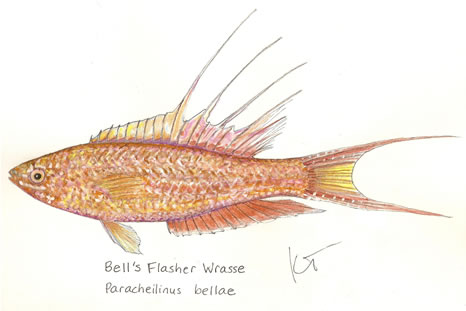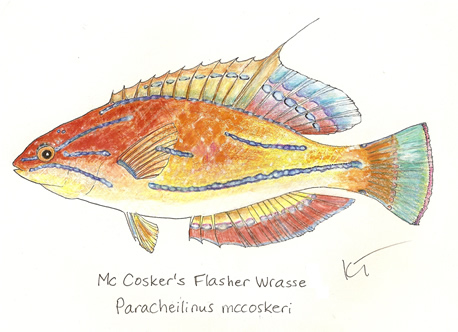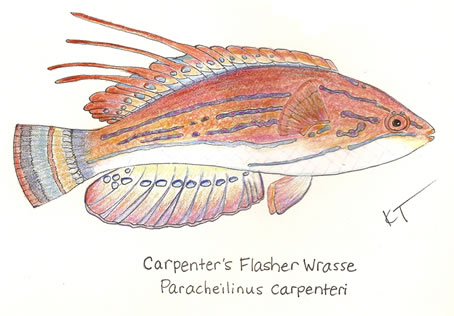|
Genus Paracheilinus - Flasher Wrasses
Flashy Fish for Your Reef Tank
 |
| The Bell’s Flasher Wrasse (P. bellae) is a deep water fish from the Marshall Islands and Palau, which is not frequently seen in the hobby. Illustration by Karen Talbot |
There are 14 described species of wrasses in the genus Paracheilinus, more commonly known as the “flasher wrasses.” Indeed, these are flashy fishes, and they also make great reef aquarium fishes.
Flashing Behavior
While flashing may have dubious (if not outright disturbing connotations for humans), flashing is a natural and quite desirable behavior demonstrated by some marine fishes. Fishes are said to be flashing when they dive toward an object or into the substrate and then quickly flash back. They may do this for two main reasons. First, they may be attempting to dislodge a parasite attached to their flesh by rubbing against live rock, an aquarium decoration or the substrate itself. Second, and as is the case with flasher wrasses, they may be attempting to impress females by quickly emerging from the reefscape, displaying their flashy coloration and showy finnage and then diving back into the live rock or coral. When a male flasher wrasse is kept with two or more female wrasses of the same species, the aquarist is in for quite a show.
Family Labridae
Before discussing species specifics, it’s worth taking a look at wrasses as a group. All wrasses are from the Family Labridae (from the Greek “labrum” or “lip”). This is one of the larger families of reef fishes, and, as such, there are many variations in behavior, diet, husbandry, and aquarium suitability. Most wrasses are small (as small as two inches), but a few grow to more than six feet in length. They all have protractile mouths, cycloid scales and a lateral line that may either be continuous or interrupted. All are marine fishes, but there are both tropical and temperate species. Despite this variety, it is not infrequent to see wrasses offered by retailers of marine livestock broken down into two somewhat arbitrary categories—reef compatible and not reef compatible. The flasher wrasses are all considered reef compatible fishes.
Reef Compatible Flasher Wrasses
 |
| The McCosker’s falsher wrasse (P. mccoskeri) replaces the Carpenter’s flasher wrasse in the Indian Ocean. Illustration by Karen Talbot |
Flasher wrasses are zooplankton feeders (like the fairy wrasses of the genus Cirrhilabrus), and they are amongst the best wrasses for a reef aquarium. They generally stay small, are quite hardy and have generally peaceful dispositions. The males are known for their bright colors, gorgeous finnage and flashing behavior. A single male should be kept with two or more females to form a harem.
Despite their flashy appearance, these are generally peaceful fishes that need to be housed with peaceful tankmates. Two of the most popular flasher wrasses are the filamented flasher wrasse (P. filamentosus) and the Carpenter’s flasher wrasse (P. carpenter). Other popular, although not as commonly seen, species include the McCoskeri flasher wrasse (P. mccoskeri) and (P. octotaenia).
Filamented Flasher Wrasse (P. filamentosus)
This flasher wrasse (to just shy of six inches), sometimes called the filamentous wrasse, the filament-fin wrasse, or the filamentous wrasse, is indigenous to the Indo-Pacific, where it primarily inhabits rubble zones in passages and outer reef slopes. The filamented flasher wrasse forms large shoals most commonly at depths of 70 feet, although small shoals may also be observed at depths of thirty feet or less. There is some geographical variation in the male’s colors based on the presence of similar species in the same general vicinity. Regardless, the male is a very attractive fish with a crescent-shaped (lunate) caudal fin and greatly prolonged dorsal rays. Both males and females possess four or five narrow red to blue stripes, which alternate in length. Some females (depending on geographical location) also have elongate dorsal rays, although they are much shorter than the male’s in all cases. Expect male filamented flasher wrasses to display their colors and finnage to other males and available females.
Carpenter’s Flasher Wrasse (P. carpenter)
 |
| The Carpenter’s Flasher Wrasse (P. carpenter) is one of the smaller flasher wrasses, growing to about three inches. Illustration by Karen Talbot |
The Carpenter’s flasher wrasse, sometimes called the pink flasher or the redfin flasher, is one of the smaller flasher wrasses seen in the hobby (rarely exceeds three inches). It is indigenous to the Western Pacific from the Philippines north to Taiwan and Iriomotejima and south to northern Bali and Flores. This species is most commonly found near the base of steep outer reef slopes above rubble zones or coral in water 70 feet or deeper. In the Indian Ocean, the Carpenter’s flasher wrasse is replaced by the McCosker’s flasher wrasse (P. mccoskeri). Male carpenter’s flasher wrasses are usually redish orange to yellow with a yellow to white underside. The dorsal rays are prolonged, and the fish’s color deepens during courtship. Males are slightly larger than females, which are generally paler in color and almost entirely white ventrally.
Husbandry: Habitat
In terms of husbandry, the filamented flasher wrasse and the carpenter’s flasher wrasse (and McCoskeri flasher wrasse, for that matter) are very similar. They should be placed in an aquarium of at least 30 gallons (larger if you intend to keep a group) that has plenty of live rock. If you are going to keep a small group (which is recommended), add the females first; otherwise add them all at the same time. Most wrasses appreciate a sandy substrate.
Husbandry: Diet
Although shy at first, both species should readily accept a captive diet of varied foods including meaty bits of marine flesh such as raw table shrimp, squid, clam, and mussel. Supplement this with some type of herbivorous food such as a flake food formulated for herbivores or seaweed strips like Sea Veggies or nori. Nearly all will readily take commercially prepared pellet food and frozen food. Having a refugium be part of the filtration on a flasher wrasse tank is an excellent idea, as their metabolism is quite high, and a mature refugium will provide a constant food supply. Otherwise, plan to feed your flasher wrasses a little bit, often.
Husbandry: Reproduction & Flashing
“One of the biggest questions we get about flasher wrasses is will my male flasher wrasse flash?” says Mark Martin, director of marine ornamental research at Blue Zoo Aquatics. “Flasher wrasse males will flash—or become what some call ‘supermales’—in the presence of females OR other males of similar species. Keeping males of similar species together, such as a male Carpenter’s and a male McCoskeri, is actually a trick that we recommend for both flasher and fairy wrasses.”
Martin’s advice is particularly useful for species where it is difficult to acquire females. “Often time the females are not collected,” says Martin. “If you have one male in a tank by itself, it will eventually lose its color. So, we will recommend people buy another male so that they keep each other brightly colored.” Do be aware that these fishes do change sex (from female to male) based on social hierarchy. In a group of females, the dominant individual will most likely become a male.
Conclusion
Flasher wrasses from the genus Paracheilinus generally-speaking make excellent tropical marine aquarium fishes. They are almost as alluring as anthias but don’t have the same dietary needs; they are as pretty as parrotfishes but remain aquarium-sized; and they are as dynamic as shoaling damsels but without the aggression. Given the proper habitat and care, it’s hard to ask for more in a relatively hardy reef fish.
Published 17 June 2008. © Blue Zoo Aquatics
|